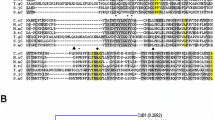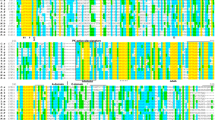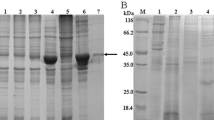Abstract
Clonorchis sinensis triosephosphate isomerase (CsTIM) is a key regulatory enzyme of glycolysis and gluconeogenesis, which catalyzes the interconversion of glyceraldehyde 3-phosphate to dihydroxyacetone phosphate. In this study, the biochemical characterizations of CsTIM have been examined. A full-length complementary DNA (cDNA; Cs105350) sequence encoding CsTIM was obtained from our C. sinensis cDNA library. The open reading frame of CsTIM contains 759 bp which encodes 252 amino acids. The amino acid sequence of CsTIM shares 60–65 % identity with other species. Western blot analysis displayed that recombinant CsTIM (rCsTIM) can be probed by anti-rCsTIM rat serum and anti-C. sinensis excretory/secretory products (anti-CsESPs) rat serum. Quantitative reverse transcription (RT)-PCR and western blotting analysis revealed that CsTIM messenger RNA (mRNA) and protein were differentially expressed in development cycle stages of the parasite, including adult worm, metacercaria, excysted metacercaria, and egg. In addition, immunolocalization assay showed that CsTIM was located in the seminal vesicle, eggs, and testicle. Moreover, rCsTIM exhibited active enzyme activity in catalytic reactions. The Michaelis constant (K m) of rCsTIM was 0.33 mM, when using glyceraldehyde 3-phosphate as the substrate. The optimal temperature and pH of CsTIM were 37 °C and 7.5–9.5, respectively. Collectively, these results suggest that CsTIM is an important protein involved in glycometabolism, and CsTIM possibly take part in many biological functions in the growth and development of C. sinensis.






Similar content being viewed by others
References
Adam RD (2001) Biology of Giardia lamblia. Clin Microbiol Rev 14:447–475
Alirahmi H, Farahnak A, Golmohamadi T, Esharghian MR (2010) Comparative assay of glutathione S-transferase (GSTs) activity of excretory-secretory materials and somatic extract of Fasciola spp parasites. Acta Med Iran 48(6):367–370
Cass CL, Johnson JR, Califf LL, Xu T, Hernandez HJ, Stadecker MJ, Yates JR 3rd, Williams DL (2007) Proteomicanalysis of Schistosoma mansoni egg secretions. Mol Biochem Parasitol 155:84–93
Chen B, Wen JF (2011) The adaptive evolution divergence of triosephosphate isomerases between parasitic and free-living flatworms and the discovery of a potential universal target against flatworm parasites. Parasitol Res 109:283–289
Choi BI, Han JK, Hong ST, Lee KH (2004) Clonorchiasis and cholangiocarcinoma: etiologic relationship and imaging diagnosis. Clin Microbiol Rev 17(3):540–552
Curwen RS, Ashton PD, Sundaralingam S, Wilson RA (2006) Identification of novel proteases and immunomodulators in the secretions of schistosome cercariae that facilitate host entry. Mol Cell Proteomics 5:835–844
Daar IO, Artymiuk PJ, Phillips DC, Maquat LE (1986) Human triosephosphate isomerase deficiency: a single amino acid substitution results in a thermolabile enzyme. Proc Natl Acad Sci U S A 83(20):7903–7907
Dabrowska A, Kamrowska I, Baranowski T (1978) Purification, crystallization and properties of triosephosphate isomerase from human skeletal muscle. Acta Biochim Pol 25:247–256
Eanes WF, Merritt TJ, Flowers JM, Kumagai S, Sezgin E, Zhu CT (2006) Flux control and excess capacity in the enzymes of glycolysis and their relationship to flight metabolism in Drosophila melanogaster. Proc Natl Acad Sci U S A 103(51):19413–19418
Figueroa-Angulo EE, Estrella-Hernández P, Salgado-Lugo H, Ochoa-Leyva A, Gómez Puyou A, Campos SS, Montero-Moran G, Ortega-López J, Saab-Rincón G, Arroyo R, Benítez-Cardoza CG, Brieba LG (2012) Cellular and biochemical char-acterization of two closely related triosephosphate isomerases from Trichomonas vaginalis. Parasitology 139(13):1729–1738
Furuya H, Ikeda R (2009) Interaction of triosephosphate isomerase from the cell surface of Cryptococcus neoformans. Microbiology 155:2707–2713
Furuya H, Ikeda R (2011) Interaction of triosephosphate isomerase from staphylococcus aureus with plasminogen. Microbiol Immunol 55:855–862
Gomez-Arreaza A, Acosta H, Quinones W, Concepcion JL, Michels PA, Avilan L (2014) Extracellular functions of glycolytic enzymes of parasites: unpredicted use ofancient proteins. Mol Biochem Parasitol 193:75–78
Guillou F, Roger E, Mone Y, Rognon A, Grunau C, Theron A, Mitta G, Coustau C, Gourbal BE (2007) Excretory–secretory proteome of larval Schistosoma mansoni and Echinostoma caproni, two parasites of Biomphalaria glabrata. Mol Biochem Parasitol 155:45–56
Jefferies JR, Campbell AM, van Rossum AJ, Barrett J, Brophy PM (2001) Proteomic analysis of Fasciola hepatica excretory–secretory products. Proteomics 1:1128–1132
Kaewkes S (2003) Taxonomy and biology of live flukes. Acta Trop 88:177–196
Kang IK, Lee SH, Seo BS (1969) Study on the (14) C-glucose metabolism by Clonorchissinensis: paper chromatographic analyses in combination with autoradiogra-phy. Kisaengchunghak Chapchi 7:143–152
Karkowska-Kuleta J, Kedracka-Krok S, Rapala-Kozik M, Kamysz W, Bielinska S, Karafova A, Kozik A (2011) Molecular determinants of the interaction between human high molecular weight kininogen and Candida albicans cell wall: identification of kininogen-binding proteins on fungal cellwall and mapping the cell wall-binding regions on kininogen molecule. Peptides 32:2488–2496
Keiser J, Utzinger J (2009) Food-borne trematodiases. Clin Microbiol Rev 22(3):466–483
Knowles JR (1991) To build an enzyme. Philos Trans R Soc Lond B Biol Sci 332:115–121
Lim MK, Ju YH, Franceschi S, Oh JK, Kong HJ, Hwang SS, Park SK, Cho SI, Sohn WM, Kim DI, Yoo KY, Hong ST, Shin HR (2006) Clonorchis sinensis infection and increasing risk of cholangiocarcinoma in the Republic of Korea. Am J Trop Med Hyg 75(1):93–96
Liu F, Cui SJ, Hu W, Feng Z, Wang ZQ, Han ZG (2009) Excretory/secretory proteome of the adult developmental stage of human blood fluke, Schistosoma japonicum. Mol Cell Proteomics 8:1236–1251
Lorenzatto KR, Monteiro KM, Paredes R, Paludo GP, da Fonsêca MM, Galanti N, Zaha A, Ferreira HB (2012) Fructose-bisphosphate aldolase and enolase from Echinococcus gra-nulosus: genes, expression patterns and protein interactions of two potentialmoonlighting proteins. Gene 506:76–84
Lun ZR, Gasser RB, Lai DH, Li AX, Zhu XQ, Yu XB, Fang YY (2005) Clonorchiasis: a key foodborne zoonosis in China. Lancet Infect Dis 5(1):31–41
Mulvenna JI, Sripa B, Brindley PJ, Gorman J, Jones MK, Colgrave ML, Jones A, Nawaratna S, Laha T, Suttiprapa S, Smout MJ, Loukas A (2010) The secreted and surface proteomes of the adult stage of the carcinogenic human liver fluke Opisthorchis viverrini. Proteomics 10:1063–1078
Na BK, Kang JM, Sohn WM (2008) CsCF-6, a novel cathepsin F-like cysteine protease for nutrient uptake of Clonorchis sinensis. Int J Parasitol 38:493–502
Orosz F, Olah J, Ovadi J (2009) Triosephosphate isomerase deficiency: new insights into an enigmatic disease. Biochim Biophys Acta 1792:1168–1174
Ostoa-Saloma P, Garza-Ramos G, Ramírez J, Becker I, Berzunza M, Landa A, Gómez-Puyou A, Tuena de Gómez-Puyou M, Pérez-Montfort R (1997) Cloning, expression, purification and characterization of triosephosphate isomerase from Trypanosoma cruzi. Eur J Biochem 244(3):700–705
Pereira LA, Bao SN, Barbosa MS, Silva JL, Felipe MS, de Santana JM, Mendes-Giannini MJ, de Almeida Soares CM (2007) Analysis of the Paracoccidioides brasiliensis triosephosphate isomerase suggests the potential for adhesin function. FEMS Yeast Res 7:1381–1388
Pfaffl MW (2001) A new mathematical model for relative quantification in real-time RT-PCR. Nucleic Acids Res 29(9):e45
Ralser M, Heeren G, Breitenbach M, Lehrach H, Krobitsch S (2006) Triose- phosphate isomerase deficiency is caused by altered dimerization not catalytic inactivity e of the mutant enzymes. PLoS ONE 1:e30
Roland BP, Stuchul KA, Larsen SB, Amrich CG, Vandemark AP, Celotto AM, Palladino MJ (2013) Evidence of a triosephosphate isomerase non-catalytic function crucial to behavior and longevity. J Cell Sci 126(pt 14):3151–3158
Sanabria-Ayala V, Belmont I, Abraham L (2015) Triosephosphate isomerase of Taenia solium (TTPI): phage display and antibodies as tools for finding target regions to inhibit catalytic activity. Parasitol Res 114(1):55–64
Seigle JL, Celotto AM, Palladino MJ (2008) Degradation of functional triose- phosphate isomerase protein underlies sugarkill pathology. Genetics 179:855–862
Shin HR, Oh JK, Masuyer E, Curado MP, Bouvard V, Fang YY, Wiangnon S, Sripa B, Hong ST (2010) Epidemiology of cholangiocarcinoma: an update focusing on risk factors. Cancer Sci 101(3):579–585
Tielens AG, van den Heuvel JM, van den Bergh SG (1987) Differences in intermediaryenergy metabolism between juvenile and adult Fasciola hepatica. Mol Biochem Parasitol 24:273–281
Velur Selvamani RS, Telaar M, Friehs K, Flaschel E (2014) Antibiotic-free segregational plasmid stabilization in Escherichia coli owing to the knockout of triosephosphate isomerase (tpiA). Microb Cell Factories 13:58
Wang YZ (1983) Clonorchis sinensis. In: Zhao HX (ed) Human parasitology. People Health Press, Beijing, pp 451–463 (in Chinese)
Wang X, Chen W, Huang Y, Sun J, Men J, Liu H, Luo F, Guo L, LLv X, Deng C, Zhou C, Fan Y, Li X, Huang L, Hu Y, Liang C, Hu X, Xu J, Yu X (2011) The draft genome of the carcinogenic human liver fluke Clonorchis sinensis. Genome Biol 12(10):R107
Wilson RA (2012) Proteomics at the schistosome-mammalian host interface: any prospects for diagnostics or vaccines? Parasitology 139:1178–1194
Xu Y, Chen W, Bian M, Wang X, Sun J, Sun H, Jia F, Liang C, Li X, Zhou X, Huang Y, Yu X (2013) Molecular characterization and immune modulation properties of Clonorchis sinensis-derived RNASET2. Parasite Vectors 6:360
Young ND, Campbell BE, Hall RS, Jex AR, Cantacessi C, Laha T, Sohn WM, Sripa B, Loukas A, Brindley PJ, Gasser RB (2010) Unlocking the transcriptomes of two carcinogenic parasites, Clonorchis sinensis and Opisthorchis viverrini. PLoS Negl Trop Dis 4(6):e719
Zheng M, Hu K, Liu W, Hu X, Hu F, Huang L, Wang P, Hu Y, Huang Y, Li W, Liang C, Yin F, He Q, Yu X (2011) Proteomic analysis of excretory secretory products from Clonorchis sinensis adult worms: molecular characterization and serological reactivityof a excretory–secretory antigen-fructose-1,6-bisphosphatase. Parasitol Res 109(3):737–744
Zhou J, Sun J, Huang Y, Zhou C, Liang P, Zheng M, Liang C, Jin X, Li X, Xinbing Y (2013) Molecular identification, immunolocalization, and characterization of Clonorchis sinensis calmodulin. Parasitol Res 112:1709–1717
Zhu Y, Si J, Harn DA, Ren J, Yu C, Liang Y, Yin X, He W, Cao G (2006) Schistosoma japonicum triosephosphate isomerase plasmid DNA vaccine protects pigs against challenge infection. Parasitology 132:67–71
Zinsser VL, Farnell E, Dunne DW, Timson DJ (2013a) Triosephosphate isomerase from the fluke Schistosoma mansoni: biochemical characterisation of a potential drug and vaccine target. FEBS Lett 587(21):3422–3427
Zinsser VL, Hoey EM, Trudgett A, Timson DJ (2013b) Triose phosphate isomerase from the liver fluke Fasciola hepatica. Biochimie 95(11):2182–2189
Acknowledgments
This study was funded by the National Natural Science Foundation of China (No. 81101270 and No. 81171602.) and the National Important Sci-tech Special Projects (2012ZX10004220).
Author information
Authors and Affiliations
Corresponding author
Additional information
Juanjuan Zhou and Hua Liao contributed equally to this work.
Rights and permissions
About this article
Cite this article
Zhou, J., Liao, H., Li, S. et al. Molecular identification, immunolocalization, and characterization of Clonorchis sinensis triosephosphate isomerase. Parasitol Res 114, 3117–3124 (2015). https://doi.org/10.1007/s00436-015-4530-z
Received:
Accepted:
Published:
Issue Date:
DOI: https://doi.org/10.1007/s00436-015-4530-z




